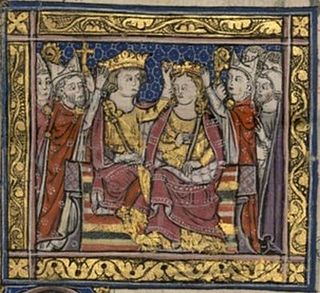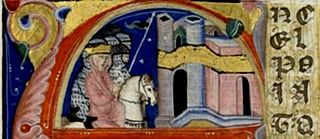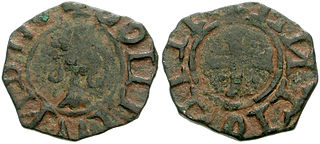Related Research Articles

Aimery of Lusignan, erroneously referred to as Amalric or Amaury in earlier scholarship, was the first King of Cyprus, reigning from 1196 to his death. He also reigned as the King of Jerusalem from his marriage to Isabella I in 1197 to his death. He was a younger son of Hugh VIII of Lusignan, a nobleman in Poitou. After participating in a rebellion against Henry II of England in 1168, he went to the Holy Land and settled in the Kingdom of Jerusalem.

The Kingdom of Jerusalem, also known as the Latin Kingdom, was a Crusader state that was established in the Levant immediately after the First Crusade. It lasted for almost two hundred years, from the accession of Godfrey of Bouillon in 1099 until the fall of Acre in 1291. Its history is divided into two periods with a brief interruption in its existence, beginning with its collapse after the siege of Jerusalem in 1187 and its restoration after the Third Crusade in 1192.

The Eighth Crusade was the second Crusade launched by Louis IX of France, this one against the Hafsid dynasty in Tunisia in 1270. It is also known as the Crusade of Louis IX Against Tunis or the Second Crusade of Louis. The Crusade did not see any significant fighting as Louis died of dysentery shortly after arriving on the shores of Tunisia. The Treaty of Tunis was negotiated between the Crusaders and the Hafsids. No changes in territory occurred, though there were commercial and some political rights granted to the Christians. The Crusaders withdrew back to Europe soon after.

Maria of Montferrat (1192–1212) was the queen of Jerusalem from 1205 until her death. Her parents were Isabella I and her second husband, Conrad of Montferrat. Maria succeeded her mother under the regency of her half-uncle John of Ibelin. After him the kingdom was ruled on Maria's behalf by her husband, John of Brienne, whom she married in 1210. She died giving birth to her successor, Isabella II.
Hugh III, also called Hugh of Antioch-Lusignan and the Great, was the king of Cyprus from 1267 and king of Jerusalem from 1268. Born into the family of the princes of Antioch, he effectively ruled as regent for underage kings Hugh II of Cyprus and Conrad III of Jerusalem for several years. Prevailing over the claims of his cousin Hugh of Brienne, he succeeded both young monarchs upon their deaths and appeared poised to be an effective political and military leader.

Alice of Champagne was the queen consort of Cyprus from 1210 to 1218, regent of Cyprus from 1218 to 1223, and of Jerusalem from 1243 to 1246. She was the eldest daughter of Queen Isabella I of Jerusalem and Count Henry II of Champagne. In 1210, Alice married her step-brother King Hugh I of Cyprus, receiving the County of Jaffa as dowry. After her husband's death in 1218, she assumed the regency for their infant son, King Henry I. In time, she began seeking contacts within her father's counties in France to bolster her claim to Champagne and Brie against her cousin, Theobald IV. However, the kings of France never acknowledged her claim.

Hugh I succeeded to the throne of Cyprus on 1 April 1205 underage upon the death of his elderly father Aimery, King of Cyprus and Jerusalem. His mother was Eschiva of Ibelin, heiress of that branch of Ibelins who had held Bethsan and Ramleh.

Henry I of Cyprus, nicknamed the Fat was King of Cyprus from 1218 to 1253. He was the son of Hugh I of Cyprus and Alice of Champagne. When his father Hugh I died on January 10, 1218, the 8-month-old Henry became king. His mother was the official regent, but delegated governing to her uncle, Philip of Ibelin. When Philip died, the effective regency passed to his brother, John of Ibelin, the Old Lord of Beirut.

Bohemond IV of Antioch, also known as Bohemond the One-Eyed, was Count of Tripoli from 1187 to 1233, and Prince of Antioch from 1201 to 1216 and from 1219 to 1233. He was the younger son of Bohemond III of Antioch. The dying Raymond III of Tripoli offered his county to Bohemond's elder brother, Raymond, but their father sent Bohemond to Tripoli in late 1187. Saladin, the Ayyubid sultan of Egypt and Syria, conquered the county, save for the capital and two fortresses, in summer 1188.
Plaisance of Antioch was Queen of Cyprus by marriage to King Henry I. She served as regent of the kingdoms of Cyprus and Jerusalem for their son, King Hugh II, in 1254–1261 and 1258–1261 respectively.
John I was King of Cyprus and, in contention with Charles I of Anjou, of Jerusalem from 1284 to 1285.
Hugh II of Cyprus was king of Cyprus and, from the age of 5 years, also Regent of the Kingdom of Jerusalem.

The House of Ibelin was a noble family in the Crusader Kingdom of Jerusalem in the 12th century. They rose from humble beginnings to become one of the most important families in the kingdom, holding various high offices and with extensive holdings in the Holy Land and Cyprus. The family disappeared after the fall of the Kingdom of Cyprus in the 15th century.
John of Ibelin, called the Old Lord of Beirut, was a powerful crusader noble in the 13th century, one of the best known representatives of the influential Ibelin family. The son of Balian of Ibelin and the dowager queen Maria Comnena, he had close ties with the nobility of both Cyprus and Jerusalem, since he was the half-brother of Queen Isabella I of Jerusalem. Before he was 20, he was appointed constable of Jerusalem, and a few years later became lord of Beirut. John rebuilt Beirut after Saladin's conquest, and established the grand Ibelin family palace. He served as regent of Jerusalem on behalf of his niece Maria of Montferrat from 1205 to 1210 after her mother, Queen Isabella, died. He was also regent for Isabella's grandson Henry I of Cyprus from 1228 until Henry came of age in 1232. John was known as a principled man, and was seen as the natural leader of the Christian barons in the Holy Land. He resisted the power-seeking of Frederick II, Holy Roman Emperor, in Cyprus, and opposed the imperial forces until King Henry came of age.
John of Ibelin, count of Jaffa and Ascalon, was a noted jurist and the author of the longest legal treatise from the Kingdom of Jerusalem. He was the son of Philip of Ibelin, bailli of the Kingdom of Cyprus, and Alice of Montbéliard, and was the nephew of John of Ibelin, the "Old Lord of Beirut". To distinguish him from his uncle and other members of the Ibelin family named John, he is sometimes called John of Jaffa.
Maria of Antioch was a claimant to the throne of the Kingdom of Jerusalem from 1268 to 1277. In 1267 she laid claim to govern the kingdom as regent in the name of the absentee King Conrad III. Her legal case was solid, resting on the proximity of blood to the king, but she was rejected by the High Court of Jerusalem in favor of Hugh III of Cyprus. When Conrad died in 1268, she demanded to be crowned as his successor. Spurned yet again for Hugh, she moved to Europe and eventually sold her claim to Charles I of Anjou.
Henry of Antioch was a nobleman from the Latin East who governed the Kingdom of Jerusalem from 1263 until 1264. He was made bailli by his wife, Isabella of Cyprus, who exercised regency on behalf of their nephew King Hugh II of Cyprus. He died in a shipwreck after their son, Hugh III, became king of both Cyprus and Jerusalem.
Mary of Lusignan, was the wife of Count Walter IV of Brienne and Countess of Brienne from the time of her marriage in 1233 to her husband's death while on Crusade in 1244. Mary's parents were King Hugh I of Cyprus and Alice of Champagne, making her a maternal granddaughter of Queen Isabella I of Jerusalem. Her two surviving sons were John, Count of Brienne, and Hugh of Brienne.
Stephanie of Armenia, also known as Rita, was a member of the Rubenid dynasty and claimant to the throne of the Armenian Kingdom of Cilicia.
Walter of Montbéliard was regent of the Kingdom of Cyprus from 1205 to 1210, and Constable of Jerusalem from around 1204 to his death.
References
- 1 2 Runciman 1989, p. Appendix III (Genealogical tree No. 1.).
- 1 2 Edbury 1994, p. 86.
- ↑ Runciman 1989, p. 206.
- 1 2 Runciman 1989, p. 289.
- ↑ Edbury 1994, p. 82.
- 1 2 3 Edbury 1994, p. 88.
- ↑ Riley-Smith 1973, p. 218.
- 1 2 Riley-Smith 1973, p. 217.
Sources
- Edbury, Peter W. (1994). The Kingdom of Cyprus and the Crusades. Cambridge University Press. ISBN 978-0-521-45837-5.
- Riley-Smith, Jonathan (1973). The feudal nobility and the kingdom of Jerusalem, 1147 - 1277. Macmillan.
- Runciman, Steven (1989). A History of the Crusades, Volume III: The Kingdom of Acre and the Later Crusades. Cambridge University Press. ISBN 0-521-06163-6.